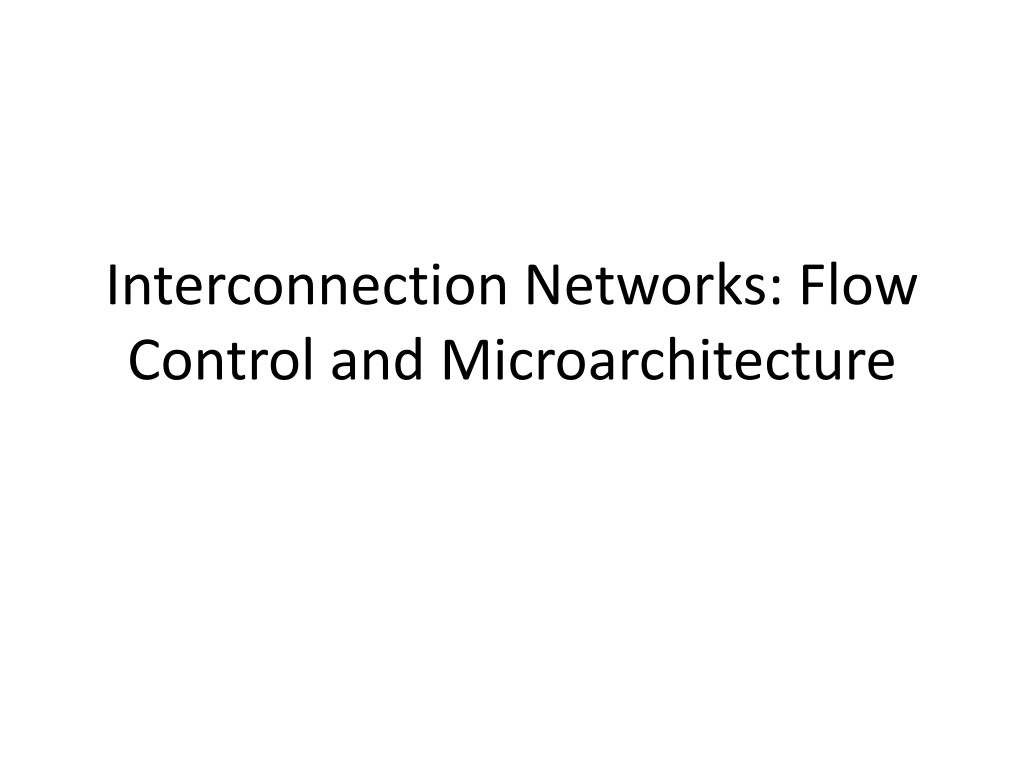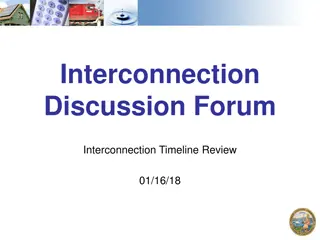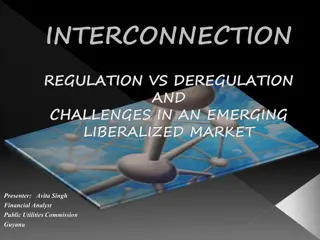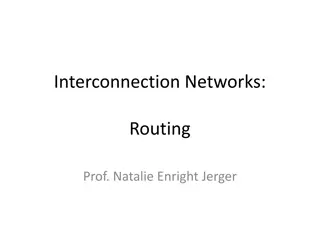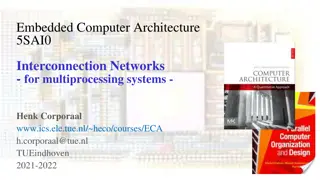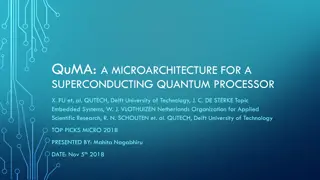Understanding Interconnection Networks, Flow Control, and Microarchitecture
Interconnection networks play a crucial role in determining the flow control and routing paths within a network, impacting throughput and latency. Different switching techniques like circuit-switching, packet-based, and flit-based control the allocation of resources at various granularities. Circuit-switching allocates all resources prior to message transport, while packet-based flow control buffers entire packets before forwarding. Each technique has its advantages and trade-offs, affecting network performance and latency.
Download Presentation

Please find below an Image/Link to download the presentation.
The content on the website is provided AS IS for your information and personal use only. It may not be sold, licensed, or shared on other websites without obtaining consent from the author. Download presentation by click this link. If you encounter any issues during the download, it is possible that the publisher has removed the file from their server.
E N D
Presentation Transcript
Interconnection Networks: Flow Control and Microarchitecture
Switching/Flow Control Overview Topology: determines connectivity of network Routing: determines paths through network Flow Control: determine allocation of resources to messages as they traverse network Buffers and links Significant impact on throughput and latency of network
Packets Messages: composed of one or more packets If message size is <= maximum packet size only one packet created Packets: composed of one or more flits Flit: flow control digit Phit: physical digit Subdivides flit into chunks = to link width In on-chip networks, flit size == phit size. Due to very wide on-chip channels
Switching Different flow control techniques based on granularity Circuit-switching: operates at the granularity of messages Packet-based: allocation made to whole packets Flit-based: allocation made on a flit-by-flit basis
Circuit Switching All resources (from source to destination) are allocated to the message prior to transport Probe sent into network to reserve resources Once probe sets up circuit Message does not need to perform any routing or allocation at each network hop Good for transferring large amounts of data Can amortize circuit setup cost by sending data with very low per- hop overheads No other message can use those resources until transfer is complete Throughput can suffer due setup and hold time for circuits
Circuit Switching Example 0 Configuration Probe 5 Data Circuit Acknowledgement Significant latency overhead prior to data transfer Other requests forced to wait for resources
Packet-based Flow Control Store and forward Links and buffers are allocated to entire packet Head flit waits at router until entire packet is buffered before being forwarded to the next hop Not suitable for on-chip Requires buffering at each router to hold entire packet Incurs high latencies (pays serialization latency at each hop)
Store and Forward Example 0 5 High per-hop latency Larger buffering required
Virtual Cut Through Packet-based: similar to Store and Forward Links and Buffers allocated to entire packets Flits can proceed to next hop before tail flit has been received by current router But only if next router has enough buffer space for entire packet Reduces the latency significantly compared to SAF But still requires large buffers Unsuitable for on-chip
Virtual Cut Through Example 0 5 Lower per-hop latency Larger buffering required
Flit Level Flow Control Wormhole flow control Flit can proceed to next router when there is buffer space available for that flit Improved over SAF and VCT by allocating buffers on a flit- basis Pros More efficient buffer utilization (good for on-chip) Low latency Cons Poor link utilization: if head flit becomes blocked, all links spanning length of packet are idle Cannot be re-allocated to different packet Suffers from head of line (HOL) blocking
Wormhole Example Red holds this channel: channel remains idle until read proceeds Channel idle but red packet blocked behind blue Buffer full: blue cannot proceed Blocked by other packets 6 flit buffers/input port
Virtual Channel Flow Control Virtual channels used to combat HOL block in wormhole Virtual channels: multiple flit queues per input port Share same physical link (channel) Link utilization improved Flits on different VC can pass blocked packet
Virtual Channel Example Buffer full: blue cannot proceed Blocked by other packets 6 flit buffers/input port 3 flit buffers/VC
Deadlock Using flow control to guarantee deadlock freedom give more flexible routing Escape Virtual Channels If routing algorithm is not deadlock free VCs can break resource cycle Place restriction on VC allocation or require one VC to be DOR Assign different message classes to different VCs to prevent protocol level deadlock Prevent req-ack message cycles
Buffer Backpressure Need mechanism to prevent buffer overflow Avoid dropping packets Upstream nodes need to know buffer availability at downstream routers Significant impact on throughput achieved by flow control Credits On-off
Credit-Based Flow Control Upstream router stores credit counts for each downstream VC Upstream router When flit forwarded Decrement credit count Count == 0, buffer full, stop sending Downstream router When flit forwarded and buffer freed Send credit to upstream router Upstream increments credit count
Credit Timeline Node 1 Node 2 t1 Flit departs router t2 Process Credit round trip delay t3 t4 Process t5 Round-trip credit delay: Time between when buffer empties and when next flit can be processed from that buffer entry If only single entry buffer, would result in significant throughput degradation Important to size buffers to tolerate credit turn-around
On-Off Flow Control Credit: requires upstream signaling for every flit On-off: decreases upstream signaling Off signal Sent when number of free buffers falls below threshold Foff On signal Send when number of free buffers rises above threshold Fon
On-Off Timeline Node 1 Foffthreshold reached Node 2 t1 t2 Foffset to prevent flits arriving before t4 from overflowing t3 t4 Process Fonthreshold reached t5 Fonset so that Node 2 does not run out of flits between t5 and t8 t6 t7 Process t8 Less signaling but more buffering On-chip buffers more expensive than wires
Flow Control Summary On-chip networks require techniques with lower buffering requirements Wormhole or Virtual Channel flow control Dropping packets unacceptable in on-chip environment Requires buffer backpressure mechanism Complexity of flow control impacts router microarchitecture (next)
Router Microarchitecture Overview Consist of buffers, switches, functional units, and control logic to implement routing algorithm and flow control Focus on microarchitecture of Virtual Channel router Router is pipelined to reduce cycle time
Virtual Channel Router Routing Computation Virtual Channel Allocator Switch Allocator VC 0 VC 0 VC 0 MVC 0 VC x VC 0 Input Ports VC 0 MVC 0 VC x
Baseline Router Pipeline BW RC VA SA ST LT Canonical 5-stage (+link) pipeline BW: Buffer Write RC: Routing computation VA: Virtual Channel Allocation SA: Switch Allocation ST: Switch Traversal LT: Link Traversal
Baseline Router Pipeline (2) 1 2 3 4 5 6 7 8 9 Head BW RC VA SA ST LT Body 1 BW SA ST LT BW SA ST LT Body 2 BW SA ST LT Tail Routing computation performed once per packet Virtual channel allocated once per packet body and tail flits inherit this info from head flit
Router Pipeline Optimizations Baseline (no load) delay ( cycles = 5 ) + + link delay hops t serializat ion Ideally, only pay link delay Techniques to reduce pipeline stages Lookahead routing: At current router perform routing computation for next router Overlap with BW BW NRC VA SA ST LT
Router Pipeline Optimizations (2) Speculation Assume that Virtual Channel Allocation stage will be successful Valid under low to moderate loads Entire VA and SA in parallel BW NRC VA SA ST LT If VA unsuccessful (no virtual channel returned) Must repeat VA/SA in next cycle Prioritize non-speculative requests
Router Pipeline Optimizations (3) Bypassing: when no flits in input buffer Speculatively enter ST On port conflict, speculation aborted VA NRC Setup ST LT In the first stage, a free VC is allocated, next routing is performed and the crossbar is setup
Buffer Organization Physical channels Virtual channels Single buffer per input Multiple fixed length queues per physical channel
Arbiters and Allocators Allocator matches N requests to M resources Arbiter matches N requests to 1 resource Resources are VCs (for virtual channel routers) and crossbar switch ports. Virtual-channel allocator (VA) Resolves contention for output virtual channels Grants them to input virtual channels Switch allocator (SA) that grants crossbar switch ports to input virtual channels Allocator/arbiter that delivers high matching probability translates to higher network throughput. Must also be fast and able to be pipelined
Round Robin Arbiter Last request serviced given lowest priority Generate the next priority vector from current grant vector Exhibits fairness
Matrix Arbiter Least recently served priority scheme Triangular array of state bits wijfor i<j Bit wij indicates request i takes priority over j Each time request k granted, clears all bits in row k and sets all bits in column k Good for small number of inputs Fast, inexpensive and provides strong fairness
Separable Allocator Requestor 1 requesting resource A Requestor 3 requesting resource A 3:1 arbiter Resource A granted to Requestor 1 Resource B granted to Requestor 1 Resource C granted to Requestor 1 Resource D granted to Requestor 1 4:1 arbiter 3:1 arbiter 4:1 arbiter 3:1 arbiter Resource A granted to Requestor 3 Resource B granted to Requestor 3 Resource C granted to Requestor 3 4:1 arbiter Requestor 1 requesting resource D Resource D granted to Requestor 3 3:1 arbiter A 3:4 allocator First stage: decides which of 3 requestors wins specific resource Second stage: ensures requestor is granted just 1 of 4 resources
Crossbar Dimension Slicing Crossbar area and power grow with O((pw)2) Inject E-in E-out W-in W-out N-in N-out S-in S-out Eject Replace 1 5x5 crossbar with 2 3x3 crossbars
Crossbar speedup 10:5 crossbar 5:10 crossbar 10:10 crossbar Increase internal switch bandwidth Simplifies allocation or gives better performance with a simple allocator Output speedup requires output buffers Multiplex onto physical link
Evaluating Interconnection Networks Network latency Zero-load latency: average distance * latency per unit distance Accepted traffic Measure the max amount of traffic accepted by the network before it reaches saturation Cost Power, area, packaging
Interconnection Network Evaluation Trace based Synthetic trace-based Injection process Periodic, Bernoulli, Bursty Workload traces Full system simulation Interconnection Network Lecture 37
Traffic Patterns Uniform Random Each source equally likely to send to each destination Does not do a good job of identifying load imbalances in design Permutation (several variations) Each source sends to one destination Hot-spot traffic All send to 1 (or small number) of destinations Interconnection Network Lecture 38
Microarchitecture Summary Ties together topological, routing and flow control design decisions Pipelined for fast cycle times Area and power constraints important in NoC design space
Interconnection Network Summary Throughput given by flow control Latency Throughput given by routing Zero load latency (topology+routing+flo w control) Throughput given by topology Min latency given by routing algorithm Min latency given by topology Offered Traffic (bits/sec) Latency vs. Offered Traffic
Suggested Reading Flow control William J. Dally. Virtual-channel flow control. In Proceedings of the International Symposium on Computer Architecture, 1990. P. Kermani and L. Kleinrock. Virtual cut-through: a new computer communication switching technique. Computer Networks, 3(4):267 286. Jose Duato. A new theory of deadlock-free adaptive routing in wormhole networks. IEEE Transactions on Parallel and Distributed Systems, 4:1320 1331, 1993. Amit Kumar, Li-ShiuanPeh, ParthaKundu, and Niraj K. Jha. Express virtual channels: Toward the ideal interconnection fabric. In Proceedings of 34th Annual International Symposium on Computer Architecture, San Diego, CA, June 2007. Amit Kumar, Li-ShiuanPeh, and Niraj K Jha. Token flow control. In Proceedings of the 41st International Symposium on Microarchitecture, Lake Como, Italy, November 2008. Li-ShiuanPeh and William J. Dally. Flit reservation flow control. In Proceedings of the 6th International Symposium on High Performance Computer Architecture, February 2000. Router Microarchitecture Robert Mullins, Andrew West, and Simon Moore. Low-latency virtual-channel routers for on-chip networks. In Proceedings of the International Symposium on Computer Architecture, 2004. Pablo Abad, Valentin Puente, Pablo Prieto, and Jose Angel Gregorio. Rotary router: An efficient architecture for cmp interconnection networks. In Proceedings of the International Symposium on Computer Architecture, pages 116 125, June 2007. Shubhendu S. Mukherjee, PetterBannon, Steven Lang, Aaron Spink, and David Webb. The Alpha 21364 network architecture. IEEE Micro, 22(1):26 35, 2002. Jongman Kim, ChrysostomosNicopoulos, Dongkook Park, Vijaykrishnan Narayanan, Mazin S. Yousif, and Chita R. Das. A gracefully degrading and energy- efficient modular router architecture for on-chip networks. In Proceedings of the International Symposium on Computer Architecture, pages 4 15, June 2006. M. Galles. Scalable pipelined interconnect for distributed endpoint routing: The SGI SPIDER chip. In Proceedings of Hot Interconnects Symposium IV, 1996.
